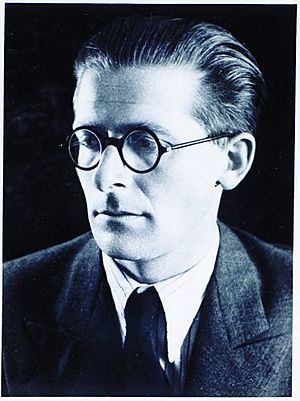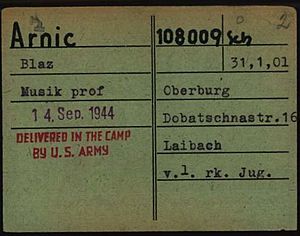Blaž Arnič facts for kids
Blaž Arnič (born January 31, 1901 – died February 1, 1970) was an important Slovenian composer. He was especially known for his symphonies, which are like big musical stories played by an orchestra.
Contents
Early Life and Musical Start
Blaž Arnič was born in a place called Luče in what was then Austria-Hungary. He grew up on a quiet farm near a mountain called Raduha. Even as a young boy, he loved music. He learned to play the accordion all by himself!
When he was 19, Arnič moved to Ljubljana, a bigger city. There, he started to study music properly.
Becoming a Composer
Arnič studied composing at the Ljubljana Conservatory. He continued his studies in other famous cities. From 1930 to 1932, he studied in Vienna, Austria. He also learned more about composing in Warsaw, Kraków, and Paris between 1938 and 1939.
He shared his musical knowledge by teaching. He taught music in Bol, a town on the island of Brač in Croatia. Later, he taught in Ljubljana in Yugoslavia.
Challenges During World War II
During World War II, Blaž Arnič faced many difficulties. In 1941, he joined the Communist Party. He also started working with a group called the Liberation Front. This group was fighting against the occupation of their country.
Because of his political beliefs, Arnič was arrested in 1943. In 1944, he was sent to the Dachau concentration camp. This was a very hard time for him. He became seriously ill there, which caused him to lose sight in one eye.
After the war ended, Arnič became a professor. He taught composing at the Academy of Music in Ljubljana. He taught there until he passed away in a car accident. Even though he had been part of the Communist Party, he later disagreed with some of their ideas. His illness, however, protected him from further trouble.
His Musical Style and Works
Arnič wrote many different kinds of music. He created pieces for choirs and for pianos. He also wrote chamber music, which is for small groups of instruments. He even composed music for films!
However, he is most famous for his nine symphonies. A symphony is a long piece of music for an orchestra. Many people consider him one of Slovenia's greatest symphonic composers of the 20th century. His music is said to be deeply connected to the spirit of his home country.
Some experts compare his music to that of Anton Bruckner. They describe his style as "neo-romantic realism." This means his music had a romantic feel but avoided harsh, clashing sounds.
Music for Films
Blaž Arnič also contributed to the world of movies. In 1948, he wrote music for a documentary film. This film was called Partizanske bolnice v Sloveniji. It was about hospitals used by partisan fighters.
Later, in 1955, his symphonic poem Ples čarovnic (which means The Dance of the Witches) was used in a film. The film was also called Ples čarovnic and starred a famous ballerina named Stanislava Brezovar.
Legacy
In 2001, Slovenia honored Blaž Arnič. They issued a special postage stamp with his picture on it. This showed how much he was respected for his contributions to music.
Principal Works
- Piano Trio (1929)
- Overture to a Comic Opera for symphony orchestra (1932)
- Symphony No. 3 – DUMA for orchestra, bass and mixed choir (1933)
- Symphony No. 5 – PARTIKULARNA (1941)
- Symphony No. 6 – SAMORASTNIK for symphony orchestra (1950)
- Ples čarovnic (The Dance of the Witches), symphonic poem (1936)
- Pesem planin (Song of the Highlands), symphonic poem (1940)
- Gozdovi pojejo (The Forests Sing), symphonic poem (1945)
- Divja jaga (Wild Chase), symphonic poem (1958–1965)
- Pastoral Symphonic Poem for violoncello and orchestra (1960)
- Concerto for viola and orchestra, Op.75 (1967)
- Concerto for violin and orchestra No. 3 (1969)



